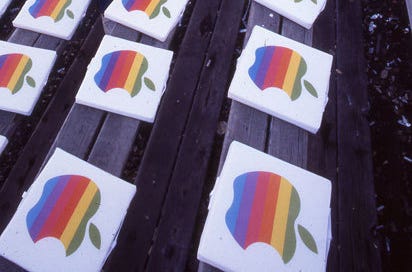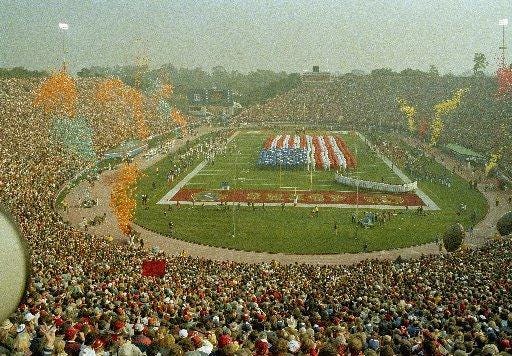Think Different (January, 1985)
Has the Super Bowl ceased to evolve--and can it regain its color?
This is Throwbacks, a newsletter by me, Michael Weinreb, about sports, history, culture and politics, and everything in-between.
If you like what you read, please click the button below, join the mailing list for FREE and please share, on social media or through e-mail or however you feel comfortable sharing.
And if you’ve been reading for a while, please consider a paid subscription to help keep this thing going—you’ll also get full access to the historical archive of over 200 articles. (Click here and you’ll get 20 percent off either a monthly or annual subscription for the first year. And if your subscription is up for renewal, just shoot me an email and I’ll figure out a way to get you that discount, as well.)
Note: This post ran in a different form a couple of years back, but the 40th anniversary of that 1985 Super Bowl seemed like a good time to revisit it with a new ending.
I.
On January 20th, 1985, the nineteenth iteration of the Super Bowl was played at a college football stadium. It was not a particularly ornate college football stadium; it was not, in fact, located on the campus of a university that cared much about college football at all. The stadium, built in 1921, was a steel bowl with hard wooden benches; one alumnus who regularly attended games there admitted that she had to “lean forward with someone’s knees in my back to watch the game.” If this stadium existed somewhere else in the world—if it were located in, say, Akron or Tulsa or Boise—there is no earthly way that the most prominent event in American sports would have been played there.
But this stadium was not located in Akron or Tulsa or Boise. It was located in Palo Alto, California, on the campus of Stanford University. At the time, Stanford Stadium had the capacity to hold more than 80,000 fans on those unforgiving wooden bleachers; it was also located in the San Francisco Bay Area, which was where then-NFL commissioner Pete Rozelle had attended college at the University of San Francisco.
If you can pinpoint a single era when the Super Bowl evolved from a “very big football game” into a pop-cultural behemoth, it has to be the 1980s. Fifteen of the first eighteen Super Bowls had been played in one of three cities—New Orleans, Miami, or Los Angeles—but by 1982, when Stanford made a push to host the game, Rozelle began to recognize that the Super Bowl had universal appeal. “Stanford was the beginning of the change with other cities getting involved,” Jim Steeg, a former NFL senior vice president who ran the Super Bowl from 1979 through 2005, told San Francisco Chronicle reporter Ron Kroichick. “Pete thought San Francisco, from his experience, was a great place to host a game: the atmosphere, the tourist attractions, the restaurants.”
II.
It didn’t matter much to Rozelle that Stanford’s campus is actually 33 miles south of the city of San Francisco; it didn’t even matter that Stanford Stadium was not a particularly nice venue. (That Stanford alum quoted above fretted further: “I’m worried about the glitzy-type people who fly in for the Super Bowl and then say, what a rotten place.”) But as was often the case, Rozelle saw an opportunity that others had yet to grasp.
In 1984, two years after the game was awarded to Stanford, a home computer company called Apple, located just a few miles from campus, aired a brash, million-dollar commercial that altered the paradigm of advertising and helped turn the Super Bowl into a pop-cultural event. The region was growing fast; Silicon Valley was an industry now, and the Super Bowl would only raise its profile further. The game had become a big enough national spectacle by 1985 that President Reagan delayed his public inauguration events by a day to make room for it; the game was growing so fast that its infrastructure could hardly keep up. Maybe if Stanford had made its bid a couple of years later, it would have been rejected. But it was too late now. The decision had been made. And Rozelle needed something to satisfy the “glitzy-type people” who increasingly made up the bulk of the Super Bowl’s in-person fan base.
So Rozelle went to Apple’s CEO, Steve Jobs, and asked if Apple might be able to provide some seat cushions that would both serve a practical use and an aesthetic use. And Jobs—who never backed away from a marketing layup—obliged, providing 84,000 cushions that are still circulating on EBay. Those cushions—and that Super Bowl—helped jump-start the modern-day Silicon Valley (for better or worse), and dashed Stanford Stadium with the kind of bright color that it needed to infuse a staid venue with modern glitz.
III.
I suppose there comes a point when anything as unfathomably huge as the Super Bowl no longer has room to grow or evolve. As much as I hate to even evoke this expression in any form, It is what it is, I’m wondering if that’s what happened to the Super Bowl about a decade ago. If you don’t believe me, perhaps this will reinforce the point:
That’s a collage of every Super Bowl logo, from I to LIX. Notice how so many reflect their time and place and their era. Notice how, at Super Bowl XLV, the logo becomes standardized, almost robbed of its color. This was a deliberate decision by the NFL, in part to incorporate the Lombardi Trophy into the design—a trophy the league had apparently long feared commercializing, because nothing matters more than preserving the sanctity of a silver football on a stick. But according to the graphic design company that helped the NFL create its newly monochrome system, the game also needed a “consistent, iconic identity.”
The interesting thing I’ve noticed, since I originally wrote this piece a few years back, is that the NFL has started infusing color back into the logo. Maybe even a league
Keep reading with a 7-day free trial
Subscribe to Throwbacks: A Newsletter About Sports History and Culture to keep reading this post and get 7 days of free access to the full post archives.






